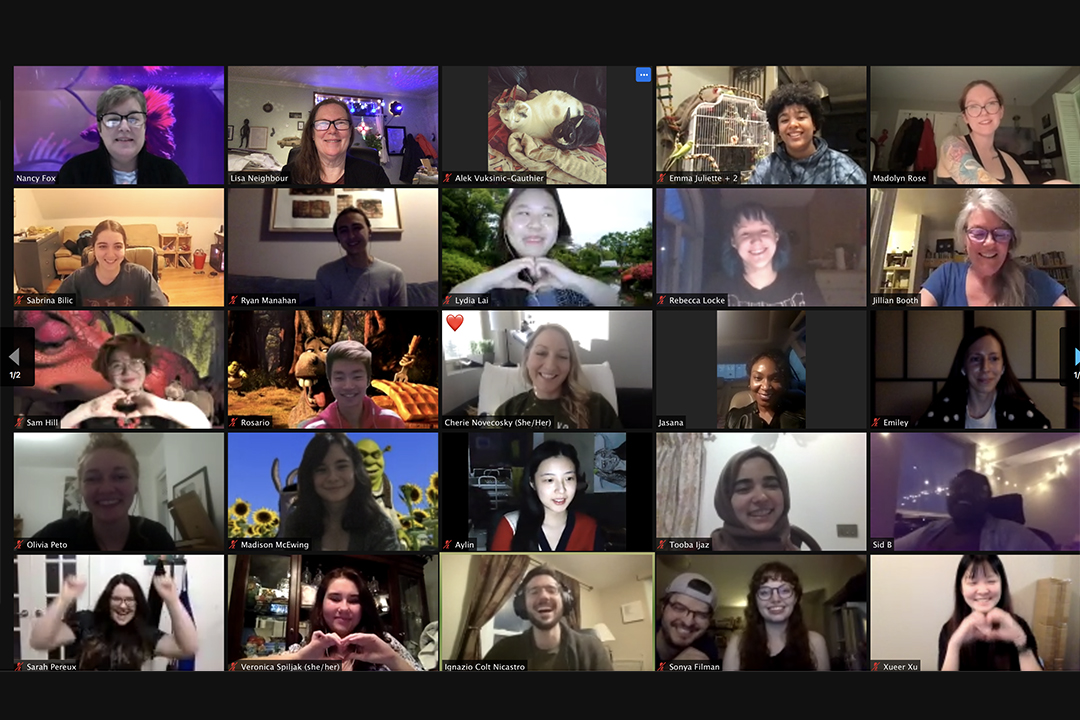If you ask any print media student at U of T to name someone who inspires them, they’d give the same answer: Lisa Neighbour, a full time printmaking instructor for print media in UTM and Sheridan’s joint Art and Art History program. The printmaker has taught as part of the program for 22 years.
I met Neighbour for the first time during a field trip to the Small Arms Inspection Building at the Toronto Biennial of Art exhibition in 2019. Though we didn’t engage in conversation, I’d never forget her beaming with admiration to a series of Inuit sculptures made of caribou teeth and whalebone. I was astonished to see an experienced artist treating an artwork with such fresh appreciation.
When I found out that Neighbour was retiring after the winter 2021 semester, I decided to interview her. What is the life story of the teacher who has motivated decades of print students?
I talked to Neighbour via Zoom. On my computer screen, I spotted rows of prints hanging across the wall behind her. Above them were two drawings of the Statue of Liberty’s torch. In an email to The Varsity, Neighbour confirmed that they were cut-outs from signs she picked up from the ground at the 2017 Women’s March in Washington. With the signs in tow, she drove from Washington back to Sheridan College so that students could take them home.
Neighbour talked about her first teaching experience at Sheridan enthusiastically. “I just loved it so much, the students were so sweet. We had a blast and made so many prints that we filled [the room]. We decided to put them all up everywhere, so it was like wallpaper… The whole place was completely covered in prints in the end.”
She continued, “There was a really great energy happening in the print studio, not to mention the extremely loud music.” Neighbour explained that she’d asked John McCartney, the technologist of the program, for a CD player in her classroom. One day, when Neighbour was teaching another class, he installed a set of stereos with core speakers into the print classroom.
“That was when I realized I was in the right place,” Neighbour recalled. “We’ve cracked [the speakers] pretty loud and they haven’t blown.” She burst into laughter. “It was almost like we were in a club.”
Neighbour, an improvisational and experimental printmaker, estimates that she’s taught print media for about 35 years. However, she first discovered printmaking during her undergraduate degree at Ontario College of Art and Design University (OCAD U). When she needed a class to fill her timetable, one of her friends recommended her to take printmaking. On the first day, her instructor asked her to put on an apron and get to work.
She ended up taking all the printmaking classes available and connected with people in the studio, many of whom remain her friends today.
After Neighbour completed her studies at OCAD U and York University, she worked as a waitress and delivery truck driver before taking on a temporary teaching job at OCAD U. “One of the faculty whose course I had taken when I was a student called me up and said they need a class assistant for a summer course,” she explains. After the summer, the college recruited her as an official staff member. “That was how I got my foot in the door. I take every opportunity.”
However, it was the exposure to toxic materials in the OCAD U’s print studios that Neighbour partially attributes to her eventual diagnosis of breast cancer. Soon after, according to Neighbour, the institution ended her employment without notice or appeal.
“I was invited [back to OCAD U] to apply to teach the course that I had designed; ironically, it was called ‘Non-toxic Printmaking’ ” Neighbour wrote in an email to The Varsity. Instead, once recovered, Neighbour took on an instructor role at Sheridan College. She then adopted water-based materials and techniques in the Sheridan print studio.
When I asked her about her perspective on teaching, Neighbour replied, “I always think of it as a collaborative process between me and all the students in my class… I wanted to learn as much as I could from them while they were also learning from me. It was more of an exchange.”
Neighbour also described that she wrote herself teaching feedback after each class. She wrote the same notes after the end of each semester, to help herself evolve her students’ curriculum.
“Everybody was there voluntarily and if they were bored, they could leave. So it was up to me to make sure that they were engaged and getting something out of [class] every single day… I always ask myself: would I want to do this? And if the answer is no, then okay bye bye, get rid of that.”
Besides teaching, Neighbour said that the greatest achievement of her life has been creating art. Throughout the years, she has showcased her work in numerous exhibitions, collaborated with artists’ collectives including Persona Volare, and travelled with her work around the world. Though Neighbour admits that her career in art was never lucrative nor always satisfying, she never considered quitting.
“I don’t really care about things; I care more about people and artwork,” said Neighbour. “[My life] is kind of like weather, with a lot of storms, but as long as I am able to get back in the studio, I can work through all the things that are happening to me and make them into something that I can draw, print, or sculpt… I hope to be doing it until the very last moment of my life.”
During retirement, Neighbour plans to visit her sister in New York, travel to Japan and Greece, cook, hang out with friends, and continue to make art.
She worded her retirement plans as “nothing huge and earth-shattering, but just enjoying the world.”


